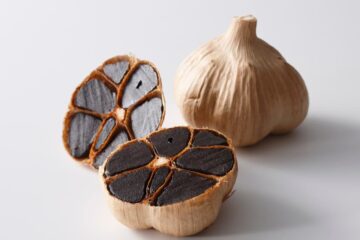Table of Contents
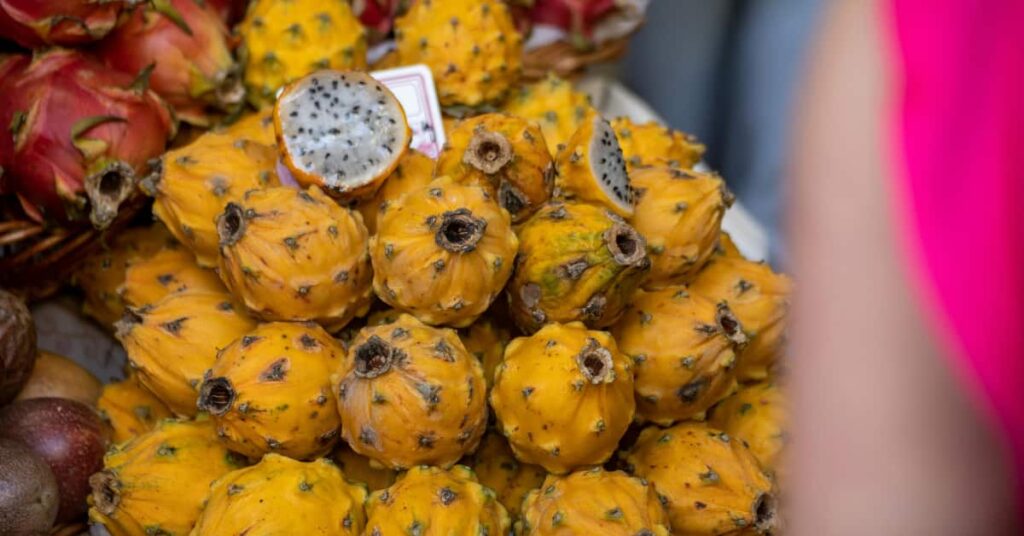
Introduction
Dragon fruit is a tropical or equatorial with lower calories, fiber, and antioxidant content. Some state it tastes like a cross between a kiwi and a pear. You can cut and consume the fruit as-is, try it with yogurt, or count it in a salad or smoothie.
It is a tropical fruit that has become increasingly famous recently.
Though individuals especially enjoy it for its distinctive look and taste, proof indicates it may also deliver health advantages.
Dragon fruit is produced on the Hylocereus cactus, also known as the Honolulu queen, whose buds only open at night.
The plant is native or mother to southern Mexico & Central America but is now cultivated worldwide.
It varies by name, including pitahaya, pitaya, and strawberry pear.
The two common types have brilliant red skin with green scales that resemble dragons, hence their name.
The most widely known kind has white pulp with black seeds, though a less familiar type with red & black seeds also exists.
Another type — yellow dragon fruit — has light skin and white pulp with black seeds.
Dragon fruit may look exotic, but its taste is identical to other fruits. Its taste has been defined as a little sweet cross between a kiwi & a pear.
Nutrition facts
Dragon fruit includes several nutrients. It’s also a respectable source of magnesium, iron, and fiber.
Here are the nutrition truths for a serving of 100 g, or 3.5 ounces:
- Calories: 57
- Fat: 0.14 grams
- Protein: 0.36 grams
- Carbs: 15 grams
- Vitamin C: 5% of the DV
- Fiber: 3 grams
- Iron: 1% of the DV
- Magnesium: 2% of the DV
Provides several antioxidants
Dragon fruit includes several kinds of antioxidants.
These combinations protect cells from unstable molecules known as free radicals, which are connected to chronic diseases and aging.
These are some of the immediate antioxidants included in dragon fruit pulp:
- Betalains: Located in the pulp of red dragon fruit, these serious red pigments have been demonstrated to greatly reduce total cholesterol, LDL, and additional health risk factor markers.
- Hydroxycinnamates: This class of compounds has shown anticancer action in test-tube and animal investigations.
- Flavonoids: This extensive, diverse group of antioxidants is linked to better brain fitness and a decreased risk of heart disease.
One study compared the antioxidant properties of 17 tropical fruits and berries.
While dragon fruit’s antioxidant power was not extremely high, it was best at covering specific fatty acids from free radical injury.
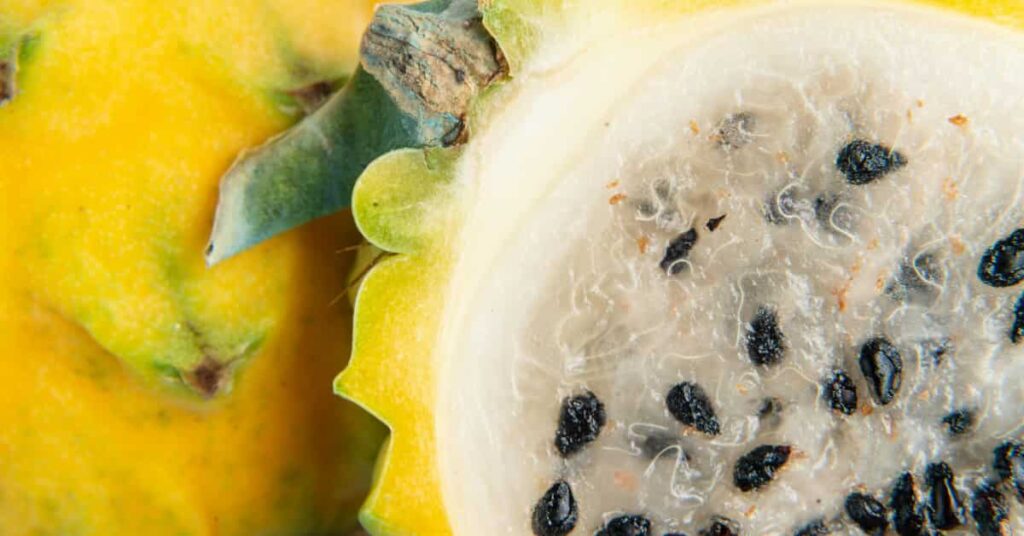
Yellow dragon fruit
Yellow Dragon fruit is a little to medium-sized species, averaging 8 to 10 centimeters in height and 6 to 7 centimeters in diameter. It has an oval to elliptical body and is less than red and pink dragon fruits. The measure mostly depends on the cultivation areas and growing requirements.
The fruit’s skin is thick, semi-smooth, and a little rubbery. When the fruit is young, it is covered in little knobby bumps that hold the divisions. As the fruit ages, the divisions naturally fall off. The skin also matures from green to light yellow.
The white, translucent flesh is dense, crisp, aqueous, tender, and succulent under the externals. The flesh is said to have a surface reminiscent of a cross between a pear & a kiwi, and numerous tiny black seeds are palatable and add a coating of crunchiness to the mouthfeel.
It should be soft when ripe and heavy for its size, meaning it has a high juice content. The skin of the fruit is not finished and should be scraped. The meat is mild, sweet, and barely tangy, with flowery & subtly fruity nuances.
Several additional kinds of dragon fruit exist, most of which are obtainable in the US (United States).
- Hylocereus megalanthus is a species or family of cactus native to Central America. It is also understood as the giant dragon fruit, and can produce up to 3 meters in height! The dragon fruit from this cactus is red or light and has pink flesh. Occasionally, the yellow skin can have green scales.
- Hylocereus undatus is a dragon fruit species native to Mexico and South America. It is also understood as the white dragon fruit with white skin and flesh. The dragon fruit from cactus is often consumed for break fast or as a snack & has a little sweet taste.
- Hylocereus costaricensis is a species or family of dragon fruit native to Costa Rica. It is also understood as the pink dragon fruit, red dragon fruit, or strawberry pear dragon fruit, with glowing pink skin and red flesh. This is the most typical dragon fruit type, often established in North America.
It can take up to three years for a dragon fruit plant to grow and produce fruit.
Dragon fruit is grown when soft to the touch and tastes sweet.

Yellow dragon fruit benefits
Dragon fruit’s other health advantages include boosting immunity, improving digestion, and aiding in weight loss.
In fact, yellow dragon fruit has gone viral on TikTok because of its purported capacity to act as a natural laxative to reduce constipation.
Dragon fruit is even thought to have anti-inflammatory properties & may aids to lower blood sugar levels.
The yellow-skinned type of dragon fruit should yield the same healthy advantages as the other types.
Here are further details about the potential health advantages of the yellow type of this exotic fruit.
1. Rich in Antioxidants
Dragon fruit is loaded with antioxidants, which assist in combating oxidative stress, free radicals, & inflammation. These contain betacyanins, hydroxycinnamates, and flavonoids.
Although yellow fruit may not have as many antioxidants as other types, it is still a good source.
2. Enhances the Immune System
The quality of the diet is one of several variables that influence the body’s capability to fight infection. By stopping damage to the white blood cells, the vitamin C & carotenoids in dragon fruit can strengthen the immune system and assist you avoid infection. The immune system’s white blood cells hunt down and stop dangerous things. Nevertheless, they are incredibly vulnerable to extreme damage. Vitamin C & carotenoids are powerful antioxidants that combat free radicals & protect the white blood cells from injury. The abundance of vitamin C & carotenoids in dragon fruit may have immune-boosting properties.
3. High in Fiber
Like numerous fruits, dragon fruit is high in dietary fiber, which profits your digestive system.
Fiber can help prevent constipation, encourage a healthy gut, and make you feel full for longer, which may contribute to weight loss.
One cup of this fruit will have between 5 & 6 grams of fiber.
Due to the high fiber content & maybe some enzymes, this fruit has anecdotal evidence that it may act as a biological laxative, which can relieve constipation.
If you are unsure how eating dragon fruit (of any color) may impact your bowel habits, start with a little amount to ensure it agrees.
4. Boosts Low Iron Levels
The yellow dragon fruit is a rare, naturally occurring fruit containing iron. Your body’s capacity to spread oxygen depends heavily on iron, crucial for transforming food into energy. Sadly, many people do not consume enough iron. Iron shortage is the most prevalent nutrient deficit globally, calculated to affect 30% of the international population. Eating a degree of iron-rich meals is essential to battling low iron levels. Wealthy sources of iron include meats, fish, legumes, nuts, and cereals.
Dragon fruit is another excellent option. One serving includes 8% of your RDI (recommended daily intake). It even contains vitamin C, which allows your body to absorb iron.
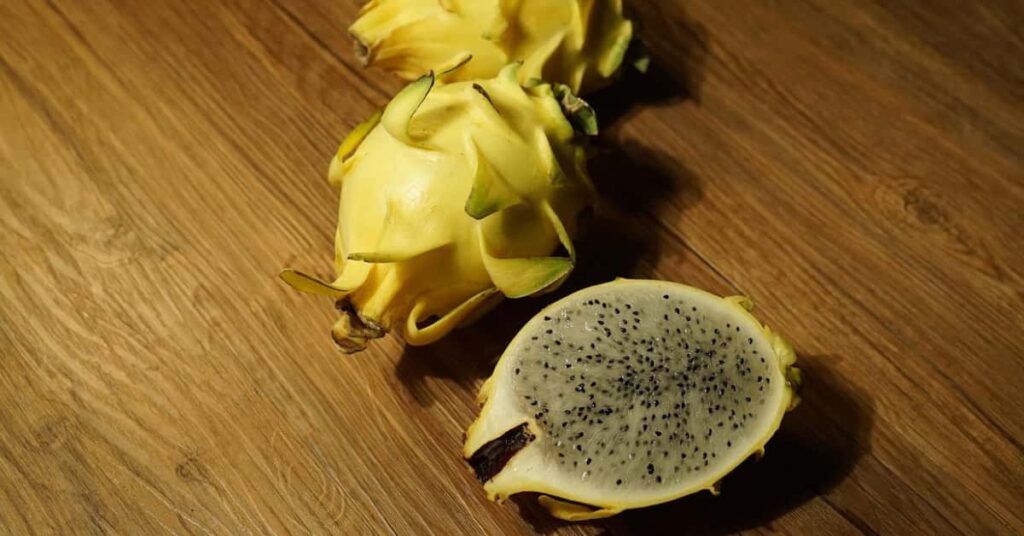
5. Vitamin C
Dragon fruit is an important source of vitamin C, which better the immune system and helps protect the body from normal illnesses and infections.
6. Combats Chronic Diseases
Hazardous chemicals, named free radicals, harm cells, resulting in inflammation and infection. Consuming foods high in antioxidants, such as dragon fruit, is one method of fighting this. By fighting free radicals, antioxidants stop cellular harm and inflammation. Investigations have revealed that a diet rich in antioxidants can help prevent chronic illnesses like diabetes, heart disease, cancer, and arthritis.
7. Loaded with Prebiotics
Yellow dragon fruit includes prebiotics, which feed the advantageous bacteria named probiotics in your gut (get my entire list of foods with natural probiotics).
Eating foods that include prebiotic fibers can assist enhance the balance of advantageous gut bacteria, which is essential for digestion & overall health.
8. Enhances Cognition
The B & C vitamins in dragon fruit support healthy cell membranes in the brain, increasing cognitive function and decreasing the risk of mental diseases.
9. Good Source of Magnesium
Dragon fruit offers a good dose of magnesium, a nutrient needed for different body functions.
These contain muscle contractions, bone health, and the production of DNA.
10. Iron and Vitamin B3
Dragon fruit is a valuable source of iron and vitamin B3.
Iron is important for blood health and oxygen transport throughout the body, while vitamin B3, or niacin, may help reduce cholesterol levels and sustain skin health.
11. Low in Calories
Despite its sweet taste, dragon fruit is relatively low in calories, making it a good choice for anyone attempting to control their calorie intake.
Be sure to talk to your doctor if you have diabetes or blood sugar problems to confirm that consuming tropical fruits is okay.
12. Promotes a Healthy Gut
Dragon fruit’s prebiotic features may promote a healthy gut, encouraging the development of beneficial bacteria.
13. Skin Health
Dragon fruit’s vitamin C range can even help support beneficial skin. Vitamin C plays a chief role in collagen production, which helps maintain firm, youthful skin.
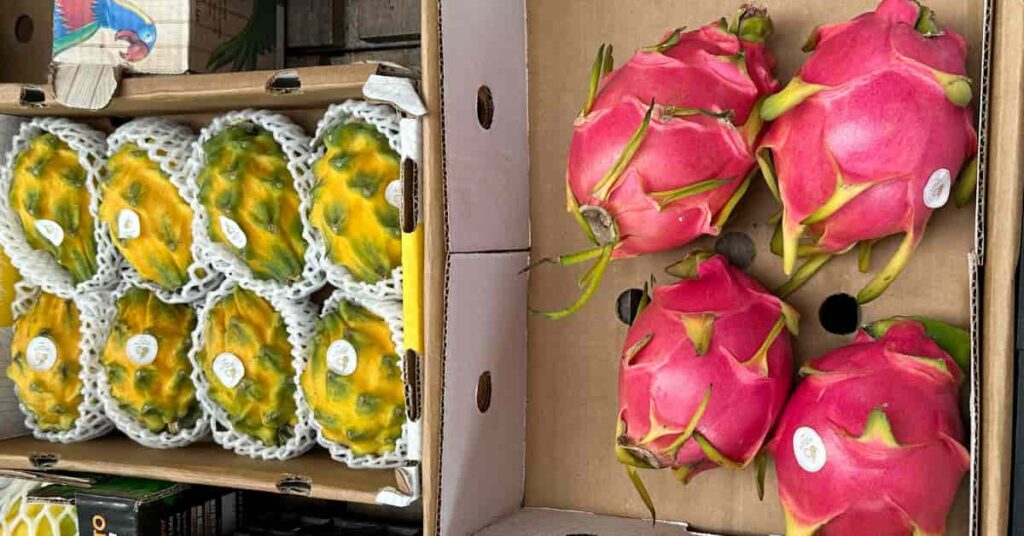
Yellow dragon fruit vs red
Yellow dragon fruit is naturally sweeter, with white, juicy flesh equivalent to a pear or kiwi, while red dragon fruit has either white or red flesh with a milder, berry-like flavor. Yellow types are less common, have spiky skin, and are usually pricier, whereas red dragon fruit is more widely obtainable with smoother skin. Both are healthy and rich in fiber and antioxidants, but the yellow dragon fruit is often considered superior in taste.
Yellow Dragon Fruit
- Flavor: Sweeter and additional flavorful, occasionally compared to lychee or a combination of kiwi and pear, with slight tartness.
- Flesh: Forever white, with a juicy texture and small, palatable black seeds.
- Appearance: Yellow, spiky skin that reaches a pine cone.
- Availability: Rarer, less ordinary, and often more costly due to longer cultivation times.
- Best For: Those seeking a delightful and fragrant flavor experience.
Red Dragon Fruit
- Flavor: Milder and sweet, with a subtly earthy, berry-like taste.
- Flesh: Can be red or white, with little larger seeds than those of the yellow variety.
- Appearance: Vibrant red skin.
- Availability: More common and inexpensive due to more rapid growth cycles.
- Best For: Those who like a mild flavor, are examining for the more readily known option, or appreciate the deep red color.
Yellow dragon fruit laxative
Yellow dragon fruit can help with constipation because it is high in fiber and water. Aids in digestion: In adding to helping you poop, the dietary fiber in yellow dragon fruit contains oligosaccharides or monosaccharides. Those nutrients include prebiotics. They promote the extension of beneficial bacteria like lactobacilli and bifidobacteria, which aid the digestive process.
Yellow dragon fruit side effects
Taking dragon fruit in moderation is secure. Nevertheless, too much fruit might result in problems like:
1. Excess of Antioxidants:
The ingestion of vast quantities of antioxidants, like beta-carotene, may result from excessive dragon fruit eating, and this may induce lung cancer. Developed vitamin E consumption even raises the possibility of hemorrhagic stroke.
2. Allergic Reaction:
Some individuals may experience an allergic response to the fruit, which can cause signs such as a burning feeling in the mouth, puffy lips and tongue, and an itchy throat.
3. Digestion Issues:
Due to its advanced fibre content, which acts as a raw laxative and facilitates smooth bowel activities, dragon fruit is naturally fantastic for the digestive tract. Nevertheless, extreme fruit eating may result in gastric jam, flatulence, stomach distress, and impaired nutrient absorption. Furthermore, these fibres take in a lot of water from the body.
Conclusion
Dragon fruit is a tropical or equatorial fruit with multiple possible health benefits. It can be located at multiple grocery stores and is usually eaten for breakfast or as a snack. Yellow dragon fruit is extremely exotic in its build, but has many of the exact health benefits of regular dragon fruit.




